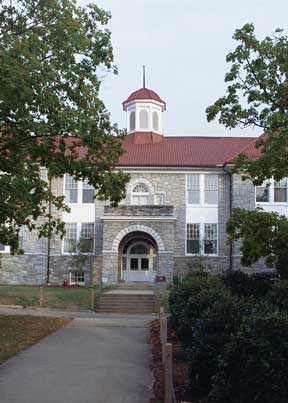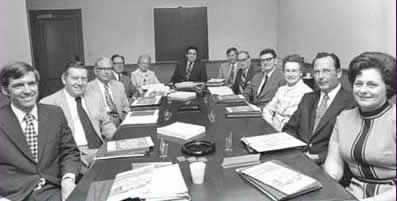Since its founding in 1908, the ultimate governing body for James Madison University and its predecessor institutions has been a board appointed by the Governor of Virginia.
In its earliest years, the State Normal and Industrial School for Women at Harrisonburg was governed by its own board of trustees.
 |
|---|
| Normal School President Julian A. Burruss (right) confers with Rockingham County State Senator George B. Keezell, who led the fight to locate the Normal School in Harrisonburg and served on its first Board of Trustees. |
About a month after signing the legislation that created the Normal School, Governor Claude A. Swanson appointed an 11-man Board of Trustees to operate the institution.
Included on the board were three local men who had been active in leading the fight to locate the school in Harrisonburg : State Senator George B. Keezell, Harrisonburg Daily News Editor Adolph H. Snyder and Rockingham County Treasurer E. W. Carpenter.
The name of the institution was changed to the Normal School for Women at Harrisonburg in 1914 and governance of the institution was shifted to a state agency, the Virginia Normal School Board.
The institution became the State Teachers College at Harrisonburg in 1924 and governance was transferred to another board appointed by the Governor, the State Board of Education.
The institution remained under the State Board of Education until 1964 when the Virginia General Assembly established independent boards of visitors for each of the state's former teachers colleges. Members are appointed by the governor.
The first board of visitors for Madison College in 1964 had 11 members, headed by Rector Burr P. Harrison of Winchester , a former Congressman from Virginia 's 7th District. Harrisonburg attorney Russell M. Weaver of Harrisonburg served as the first Vice Rector.
 |
|---|
| Madison College Board of Visitors and President Ronald E. Carrier (center) in the fall of 1972. |
By action of the Virginia General Assembly, the size of the JMU board was expanded to 15 members in 1989. Of the 15 members, no more than two can be non-residents of Virginia . Board members generally include both alumni and non-alumni of the university.
In addition to the 15 members appointed by the governor, a student representative is chosen for the board each year by the student body. The speaker of the JMU Faculty Senate also serves as the faculty representative to the board.
Visitors are appointed for terms of four years each. Visitors are not eligible to serve for more than two successive four-year terms. However, a person appointed to serve an unexpired term created by a vacancy is eligible to serve two additional four-year terms.
The non-voting student representative serves a one-year term and can be elected to a second term but is not eligible to serve for more than two successive terms. The faculty representative to the board is the speaker of the Faculty Senate. There are no board restrictions on the terms an individual may serve in this position.
